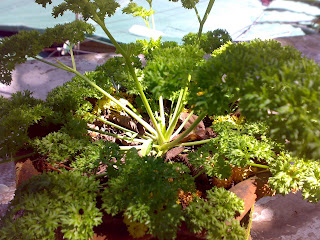Today is Sunday, October 02, 2011. Baguio City was on signal number 3 since yesterday and once again, we've lost our electricity but everything is OK now. Well, not quite normal yet because typhoon Pedring and Quiel left 53 people dead in the whole country and many more are still missing and unaccounted for not to mention those who sustained some physical injuries. These two typhoons that came one after the other has devastated the northern part of the country especially the agricultural sector. Prices of vegetables have gone up and almost doubled as a result of these typhoons because it damaged millions of crops not only in the highlands but also in the lowlands as well. In fact, many people especially in the lowlands have lost their homes and personal belongings because of the floods and many barangays are still submerged under water up to this time.
In my own backyard, part of the fence that separates our property to the public walkway at the back caved in because of the strong force of the winds. We started fixing the fence this afternoon as soon as the rain stopped and hopefully, the work will be finished tomorrow. It's a good thing that we had an extra bag of cement and some river sand and gravel that are available so we were able to start the work this afternoon. Otherwise, we would have to wait for another month to be able to bring in some construction materials because part of the street in our village has been washed out and it is not passable for any type of vehicle. Another damage in our property is the leak in the roof in our 3-bedroom transient house, that has got to be fixed too. Other than these, thank God that we are safe and sound and that is more important than any material things. I pray for those people who have lost a loved one because of the floods that they may find the strength to start all over again once everything goes back to normal.
It is at a time like this when I realize the importance of having a backyard garden because even if there will be a shortage of vegetables in the market because of these typhoons, at least there is hope that we will not go hungry as long as we have vegetables in the backyard and some backyard animals such as chickens that provides us with eggs and domesticated rabbits for meat. As soon as the immediate things are taken cared of, then I will start planning my vegetable garden in the backyard.
































